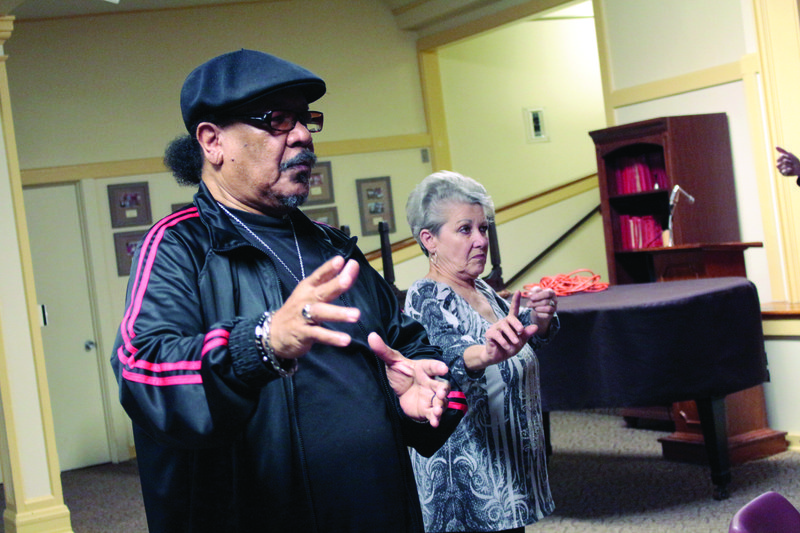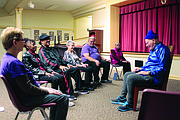As one ages, balance issues and the related fear of falling loom large: one bad fall can lead to negative lifestyle changes that may last for weeks or months or more.
Here, we examine the ways Tai Chi can benefit senior citizens, with a special focus on balance and fall prevention. In this article, Dr. Laury Hamburg, El Dorado's Tai Chi Master, will guide readers through several practices they may take to aid them in their wellness; all of these techniques can be learned in any amount of time and participants will get out of it what they put into it. Readers should always consult with a doctor before trying a new exercise routine.
Hamburg said balance and muscle strengthening exercise are the way to reduce costly falls. The exercises come easier with repetition and regularity.
Standing Exercises
Alternating arm swings: With the right foot planted, step forward onto the left foot while swinging the left arm to the rear and the right arm to the front. Then, step backward with the left foot, swinging the left arm forward and the right arm backward.
"This forward and back stepping with the arms swinging front and back can become quite rhythmic and relaxing," Hamburg said. "The number of repetitions can begin low and then increase with time."
Hamburg recommends that seniors start with 10 repetitions, noting that this exercise can become a workout on its own.
Simple sidestep-then-together: From a standing position with the feet together (called the Pose of Simplicity in Tai Chi), the left foot steps two-to-three feet to the side and the right foot closes to the left. Repeat with the right foot.
"Find a comfortable number of repetitions and add or subtract from that number based on how you feel each day," Hamburg said.
Lunges: Step forward on the left leg and then bend both knees. The thigh should be parallel to the ground. Repeat with the right leg.
"Only a few of these to start," Hamburg said.
Single foot taps: With the heel planted on the floor, raise and lower the ball of the foot, one foot at a time. The exercise can also be done with both feet simultaneously.
"No one said that you can't have some music to make things more fun," Hamburg added.
Squats: Start standing up straight with the feet hip- or shoulder-width apart. Bend the knees as if going to sit down until they are parallel to the floor. Pause for one-to-two seconds before returning to an upright position.
Sitting or Lying Down
Hamburg recommends sitting exercises including: single-leg knee raises, alternating from left to right; leg lifts, alternating; and leg kicks, alternating.
He also has a program to exercise in a prone position. He recommends practicing raising one leg and performing core exercises. He notes that one should place a pillow in the small of their back when performing such exercises.
Breathing Exercises
Hamburg said breathing exercises can help calm and focus one's mind. He suggested a simple exercise where one simply relaxes their body and breathes deeply in and out, expanding their abdomen on the inhale, and perhaps saying to themselves 'Now I'm breathing in; now I'm breathing out' as they do so to maintain focus.
"We can go months without food, weeks without water, but only minutes without air," Hamburg said. "Breathing exercises can be used to strengthen the core muscles and the major internal organs. Whole classes called Pranayama programs explore many beneficial breathing techniques."
Tai Chi
Hamburg teaches a weekly Tai Chi class for seniors at the First United Methodist Church in El Dorado. The class is held on Wednesdays at 9 a.m.
One Tai Chi exercise frequently performed in his class is the Eight Pieces of Brocade. The exercise involves eight movements, with the practitioner taking care to have each motion flow into the next.
1. Linked hands hold up the heavens: Clasp one's hands together and move them upwards, above one's hand, starting from the center of one's body.
2. Draw the bow to shoot the hawk: With the knees bent, imitate the action of drawing a bow and releasing the shot.
3. Parting the heaven and earth: Starting with one's hands in front of the trunk of their body, press one hand up and the other down; alternate hands.
4. Looking backwards: Move one's neck to the left and right, alternating.
5. Sway the head and swing the tail: With the knees bent, place one's hands on your thighs, then look backwards in both directions as far as one can.
6. Bend the body; hold the feet: Stretch upwards before bending to touch one's toes. Hamburg noted that the stretch is the important part of this exercise; if one can't reach their toes, that is OK.
7. Twist the fist with fiery eyes: With knees bent, punch outward, alternating arms, being careful to have plenty of space around oneself when performing this exercise.
8. Bouncing the bubble spring: Alternate between stretching one's toes upward while balanced on the heels and bouncing the heels upwards while balanced on the toes.
Hamburg said this Tai Chi routine is particularly helpful for balance and focus due to the alternating movements across a person's entire body and the flowing nature of the routine. Additionally, the routine stimulates one's arm, neck, back, leg and core muscles and stimulates one's organs. It is important to smile as one exercises, Hamburg said.
Hamburg's weekly Tai Chi class is free and generally lasts one hour.

